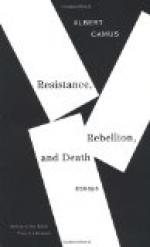“They’ve been praying for Jeffries in all the American churches,” said one, in the solemn pause that followed this announcement.
“So they have for Johnson in the negro churches,” said another, “but he counts most on his mother’s prayers. She lives in Chicago.”
“It is peculiar in modern and Christianised countries,” said Mr. Clarkson, anxious to show that he now fully understood the point at issue; “it is peculiar that the opposing parties in a war or other contest implore with equal confidence the assistance of the same deity.”
“Millionaires is sleeping three in a bed at Reno. There’s a thing!” said the man who was most anxious to impart information.
“The gate comes to L50,000, let alone the pictures,” said another. “Each of them’s going to get L500 a minute for the time they fight.”
“Beats taxis,” said the cabman.
“It’s hardly fair to criticise the amount,” Mr. Clarkson expostulated pleasantly; “the L500 represents prolonged training and practice in the art. As Whistler said, the payment is not for a day’s work, but for a lifetime.”
“Who are you calling the Whistler?” asked the cabman; “Jim Corbett, or John Sullivan?”
“Jeffries ate five lamb chops to his breakfast this morning,” said the man of information, “and Johnson ate a chicken.”
“Wish I’d eat both,” said the cabman.
“What do you think of the upper-cut?” said the other, turning to Mr. Clarkson to escape the cabman’s frivolity.
“Well, I suppose it’s a matter of taste—upper-cut or under-cut,” Mr. Clarkson answered, smiling at his seriousness. “Most people, I think, prefer under-cut.”
“Johnson’s right upper-cut is described as the piston of an ocean greyhound making twenty-seven knots,” said the man, taking no notice of the answer, and speaking in awestruck tones. “Do you know, one paper describes Johnson as the best piece of fighting machinery the world has ever seen!”
“I thought that was the last Dreadnought?” said Mr. Clarkson.
“Perhaps you don’t study the literature of the Ring,” the other answered, with cold superiority.
“Oh, indeed I do!” cried Mr. Clarkson eagerly. “It is rather remarkable what a fascination the art of boxing has frequently exercised upon the masters of literature. Even the Greeks, in spite of their artistic reverence for the human body, practised boxing with extreme severity, and on their statues, you know, we sometimes find a recognised distortion which they called ‘the boxer’s ear.’ It seems to show that they hit round rather than straight from the shoulder. The ancient boxing-gloves were intended, not to diminish, but to increase the severity of the blow, being made of seven or eight strands of cow-hide, heavily weighted with iron and lead. There is that fine description of a prize-fight in Virgil, where the veteran—’the imperturbable colossus’ of his time, I suppose we may call him—almost knocks the life out of the younger man, and sends him from the contest swinging his head to and fro, and spitting out teeth mingled with blood—rather a horrible picture!”




